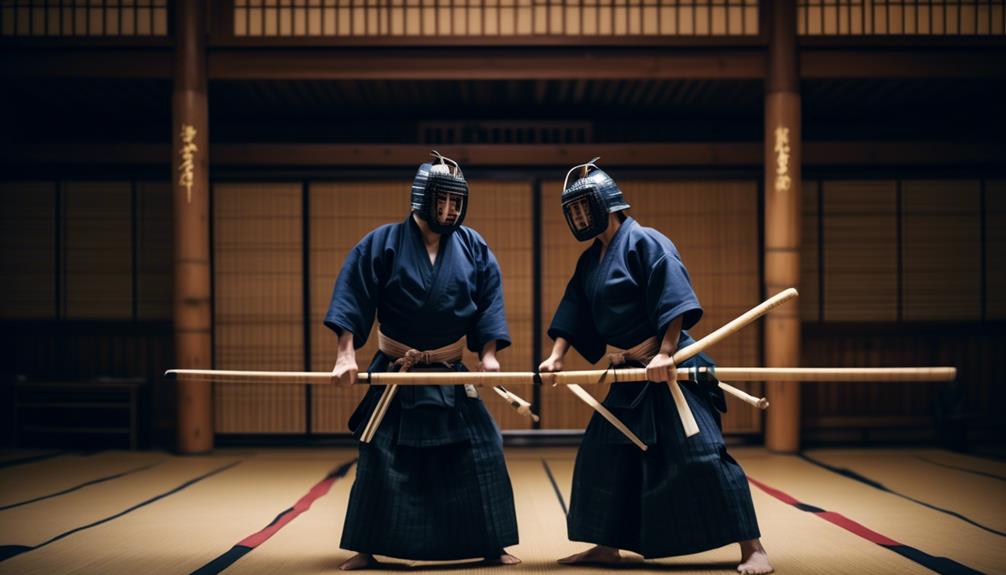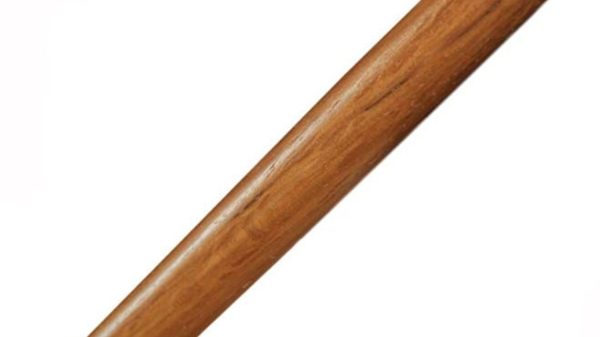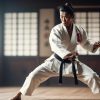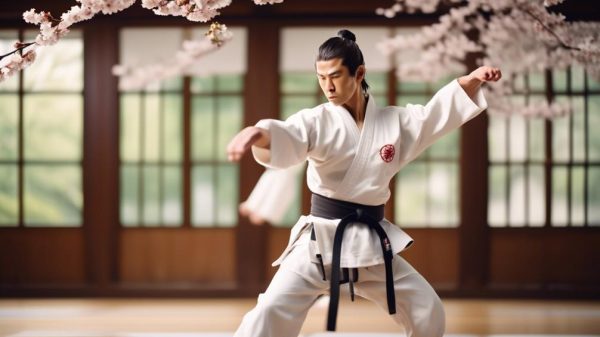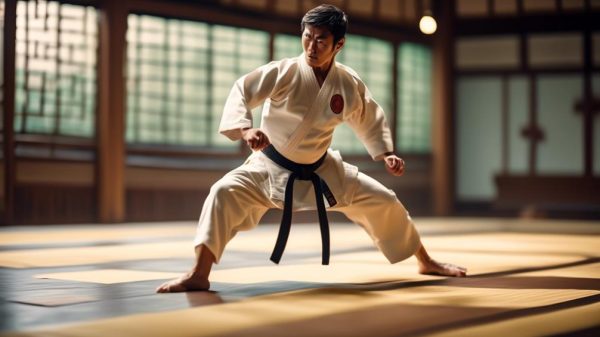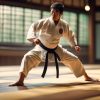This is the second part of our Kendo Kata series.
As you strive to hone your Kendo skills, you’ll find a new challenge in the intricate movements of Nihon-me, the second Kendo Kata.
These detailed movements and postures require precision and grace, embodying the spirit of a warrior with each step and strike.
To improve your technique, it’s essential to understand the nuances that elevate routine into ritual. This balance between power and poise lies at the core of your journey in Kendo.
Uncover the layers of this revered kata to fortify your skills, remembering that true proficiency unfolds one poised cut at a time.
The Essence of Kendo Kata
Understanding the essence of Kendo Kata reveals a disciplined and intricate practice where precision in strikes and parries shapes the warrior’s spirit.
As both Uchidachi and Shidachi, practitioners embody the rigor and artistry of Kendo Kata, a fundamental part of Japanese martial arts training.
This detailed sequence goes beyond physical ability; it’s a mental challenge that demands unwavering focus.
Kendo Kata cultivates muscle memory, ensuring the body instinctively aligns with the power of movements. With progression, the kata becomes second nature, allowing practitioners to concentrate on refinement.
It’s not just about striking and defending; it’s about mastering the art of timing and speed—where timing and correct speed become allies.
The precise instructions for Kendo Kata are designed to enhance skills with each repetition. They aid in practicing specific moves that are pillars of Kendo, ensuring that every step and breath is purposeful.
With every three big steps forward in the chudan position and the five small steps to the rear while maintaining zanshin, practitioners aren’t just moving; they’re growing stronger, sharper, and more present.
Mastery beckons, and practitioners respond with unwavering resolve.
Unpacking Kendo Kata
Delve into the world of Kendo Kata, where each movement and stance mastered brings you closer to the essence of Kendo. As you assume the chudan position with your partner, the dance of Uchidachi and Shidachi unfolds.
Together, take three purposeful steps forward, each a testament to discipline. Blades meet at the right kote, exemplifying the precision demanded by Kendo kata.
In this intricate choreography, factors such as accuracy and zanshin aren’t mere details; they’re the very essence of practice. They reflect understanding and mastery, shaping you into a Kendo practitioner of the highest caliber.
The conclusion of Kendo Kata isn’t merely the end of a sequence; it’s a reaffirmation of commitment, taking five small steps back, yet always ready, always focused.
For students seeking mastery, video resources can be invaluable. The video of Kendo Kata from Norwalk Kendo Dojo offers additional kata instruction, helping to refine technique.
Watch, learn, and absorb, improving your grasp of the kata’s nuances. Embrace each practice session as an opportunity to sharpen skills and embody the spirit of Kendo.
Key Movements Explained
Understand the essence of Nihon-me as you embody the roles of Uchidachi and Shidachi, mastering the crucial movements that define Kendo Kata.
Precision and fluidity are essential in this Kata. As Uchidachi, lead with your right foot to deliver a decisive cut. Shidachi responds with agility, skillfully evading the sword by shifting the left foot with finesse, creating a dance of action and reaction.
The Kata represents more than just a series of steps; it embodies the spirit of Kendo. Achieving mastery of these movements demands dedication beyond regular practice. Consider these vital elements:
- Both Uchidachi and Shidachi must assume the chudan stance with a composed yet vigilant presence.
- Uchidachi’s cut targets the right kote, executed with a balance that belies the speed of their movements.
- Shidachi evades the sword with a grace that reflects hours of honing perception and reflexes.
- The counterattack isn’t simply a motion; it’s the embodiment of Shidachi’s strategic acumen, delivering a cut with precision that disrupts Uchidachi’s flow.
The interplay of blades in Kendo Kata isn’t merely a display—it hones the spirit of a Kendoka.
Training Tips and Techniques
To enhance your Kendo kata performance, focus on consistent practice that sharpens your precision, power, and timing. Every element of your kata, perfected through relentless training, reflects the mastery you seek.
Remember, when wielding your sword, each movement must be deliberate, each strike a testament to your commitment.
The Japan Kendo Federation places significant emphasis on accuracy; therefore, precision isn’t just recommended, it’s mandatory.
As you train, visualize the path of your sword, and ensure that your right foot and delivers each technique with unwavering intent. Your footwork isn’t merely a foundation; it’s the rhythmic pulse that drives the dance of blades.
Power and speed are your allies, but without control, they’re untamed forces. Students are judged by the strength and swiftness of their execution, yet it’s the seamless harmony of these elements that distinguishes the proficient from the exceptional.
Immerse yourself in the rhythm of the kata, for timing is the invisible thread that weaves your actions into a cohesive whole. Concentrate, focus, and let each breath synchronize with the cadence of your movements.
In the dojo, as in life, it’s the disciplined honing of your craft that carves the path to excellence.
Common Mistakes to Avoid
While perfecting the precision and power of each technique, it’s crucial to be mindful of the common errors that can undermine your Kendo kata performance.
As a dedicated student, you’re continuously improving, but even the smallest oversight can disrupt the flow of your kata. Recognize these common pitfalls courtesy of Norwalk Kendo and take the opportunity to progress on your path to mastery.
- Lack of Precision: Failing to execute each movement with exactness not only indicates a lack of understanding but also hampers the display of true skill.
- Lack of Force and Speed: Your strikes must embody both strength and swiftness to showcase your proficiency. Anything less undervalues your abilities.
- Inconsistent Timing: The rhythm of your kata is its heartbeat. Losing sync means losing the impact and beauty of your performance.
- Lack of Focus: A scattered mind is your greatest adversary. Don’t let a lapse in concentration be the fault that costs you the kata.
Frequently Asked Questions
How Many Katas Are There in Kendo?
In the practice of Kendo, there are 10 katas to master. The number of katas reflects the dedication required for your journey. It demands precise uniformity, diverse variety of katas, and impeccable execution timing. Keep practicing diligently to refine your skills.
Why Is Nippon Kendo Kata Important?
The importance of Nippon Kendo Kata lies in its precise training, which embodies martial philosophy and spiritual discipline. This training is vital for teaching methodology, synchronization practice, and preserving historical techniques, which are key to mastering Kendo’s cultural heritage.

